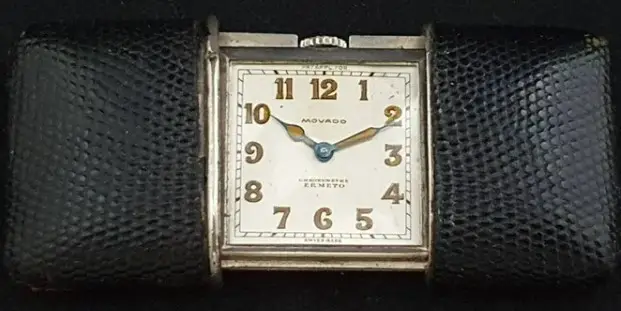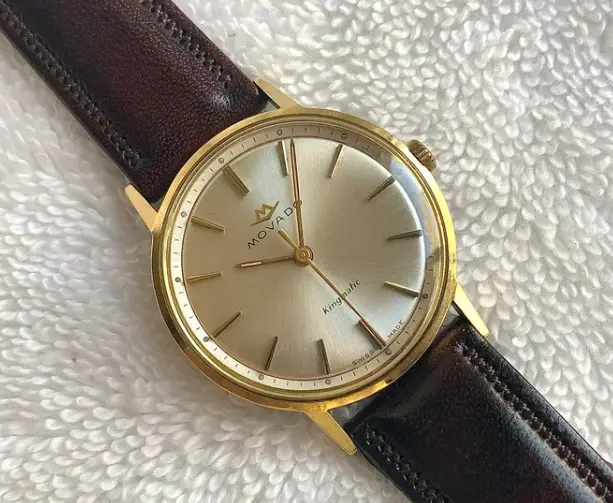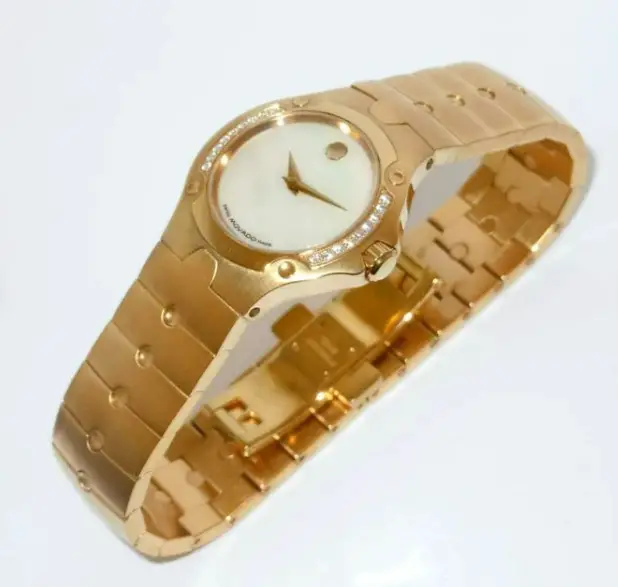Hey There! We may earn a commission from links on this page. This helps support the site and is at no extra cost to you. Thanks!
Want to learn about Vintage Movado Watches? Learn about the history, materials used, how to identify a fake, and where to buy in this guide.
“Always in motion” is the tagline for the American watch brand Movado. The company owns over 100 patents and has won over 200 international awards for their skilled Swiss craftsmanship, design, and technological innovations.
Brief History of the Movado Brand
Movado traces its roots back to Switzerland. A teenaged entrepreneur named Archilles Ditesheim, started a watch making business in La Chaux-de-Fonds, Switzerland, by hiring six local watchmakers, in 1881.
The Ditesheim family were a group of watchmakers, who already owned several businesses. Archilles along with brothers Leopold and Isidore, decided to combine their business and named it L.A. & I Ditesheim, Fabricants, in 1892. Within a twenty-year period, the successful company, known for pocket watches had 80 employees.
Later, in 1905, Archilles named the company Movado, meaning always in motion. Then, with 150 workers the company produced high quality wrist watches. Movado was eventually purchased by North American Watch Corp, in 1983, founded by Gedalio Ginberg. Today, the head office is in Paramus, New Jersey, with 1206 employees.
Bringing new ideas to traditional models of watchmaking, the Ditesheim family were innovators in the Swiss watch industry.
Vintage Styles to Look For
The Polyplan, a watch curved to the wrist was introduced by Movado, in 1912. This watch featured revolutionary movement built on three planes that were angled to fit a curved case.
In 1921, Movado started producing chronograph watches, with stop-watch features, which were at the time considered the height of modernity. For men that still enjoyed pocket watches the Art Deco creation called the Ermeto was crafted. Conveniently, it was able to self wind, when being opened and closed.

Vintage Movado Ermeto Chronograph from AntiqueUniqueGB on Etsy
By 1945, calendar watches were all the rage. These beautiful time pieces are still in demand today. Each subdial or window reflects the day, date, month and/or year. By 1947, the celestograph was introduced. It included all the features of the calendar watch, but with the addition of a moon-phase indicator.
Made from the 1950s, until the 1970s, you’ll find The Movado Polygraph World Time, with a 37 mm wide case in steel or gold. The face has the names of various cities and by turning the bezel you can set your watch to the time of your selected geographical location.
The Movado Museum Watch
In 1947, the Museum Watch was crafted by designer Nathan George Horwitt. The round black dial, or face, features a single dot at 12 o’clock. The watch face is what gives the timepiece its unique character and modernized look.
Horwitt said he was inspired by the simple designs of Bauhaus. The dot symbol is said to represent the sun rising at high noon, or a sundial, the earliest form of telling time.
Today, the watch is still in demand, and part of the collection still produced by Movado. The Museum Watch is part of the permanent collection at MoMA, in New York. It’s a symbol of art, design, and watchmaking merging. The Museum Watch would prove to be Movado’s most iconic symbol.
About Nathan George Horwitt
Although American born Nathan George Horwitt (1898-1990) was an industrial designer, he is best known for his Museum Watch, which he designed in 1947. Vacheron & Constantin-LeCoultre Watches Inc, was the first company to make it. Later it was produced by Movado.
Materials Used in Movado Watches
- Gold
- Stainless Steel
- Titanium
- Black finished stainless steel
- Gold finished stainless steel
- Rose gold finished stainless steel
- Diamonds
- Sapphire crystal
- Swarovski crystal elements
- Mother of Pearl
- Leather
- Saffriano leather
Swiss Watch Movements
There are three types of movements in Swiss made watches. The engine is the inner mechanic that allows a watch to keep time. There are two categories for movements, and these are mechanical and quartz. Manual watches and automatic watches fall under the category of mechanical watches. A quartz watch is part of the quartz category.
Manual watches need to be wound each day. Winding causes tension in the main spring. This is achieved by turning the crown. Manual movement is also called hand winding movement.

Vintage Movado Kingmatic Swiss Watch from VintageSwissWatches on Etsy
In automatic watches, the watches wind themselves automatically, with the movement of the wearer’s arm. These watches are also called self winding. This type of mechanical watch must be worn everyday to keep it moving. This is how it builds power to be able to work.
Quartz movements require a battery to make them function. It creates an electrical pulse in the quartz crystal, which moves the hands each second. This type of watch is highly accurate for telling time. A quartz movement is also called an electrical quartz movement. This type of movement was developed in the 1960s.
Jewels
Synthetic ruby or sapphire are used in Movado quartz and mechanical watches, and acts as a bearing for gears. The function is to reduce friction between mechanical parts.
Watch the World of Movado:
The Changing Face of the Museum Watch
The Museum Watch is so popular that it is now available in numerous different design materials for both men and women. Many are vintage, limited edition collectors items.
The Museum Watch for Men
The Museum Watch for men, with a link bracelet, and black face with a dot at noon, comes in 40 mm yellow gold PVD finished stainless steel, black PVD-finished stainless steel, stainless steel, or two-tone stainless steel and gold. The same style comes with 11 diamond markers, in yellow gold PVD finished stainless steel, stainless steel or two-tone. The same design comes with a mesh bracelet. With the stainless-steel mesh bracelet choose from a black or blue watch face.
For the classic style, the Museum Watch comes with leather and saffriano leather straps. You’ll find PVD-finished cases, in rose gold, yellow gold or black gold, with matching hands and dots, with faces in black or blue.
What is PVD Finish?
PVD stands for Physical Vapor Deposit, the process that uses a high-tech vacuum-coating to achieve an extremely hard finish. For gold and rose gold watches at Movado, each are given a final coating of real gold.
What is Saffriano Leather?
Saffriano leather is a leather with a distinctive cross hatch pattern. A custom machine is used by the tanner to craft it. Not only is it aesthetically pleasing to the eye, but it also provides a scratch free surface. It’s durable, easy to maintain and water resistant.

Ladies Gold Tone Movado SE Watch from ThisArtGallery on Etsy
The Museum Watch for Women
The same watches are available for women. Each watch has a smaller face, to match a smaller wrist. However, many women choose to wear men’s watches from the Movado collection, for a bolder statement.
For women there are watches with additional faces such as mother of pearl, in white, green, or even black. The beautiful 22 mm yellow gold PVD finished stainless steel, with mesh bracelet, and gold dot at 12 o’clock, comes with a mother of pearl face, encircled by 72 diamonds. Choose from black or white mother of pearl. In the stainless-steel design, it is available in white mother of pearl.
What is Mother of Pearl?
Mother of pearl is the inner lining of a freshwater mollusk shell. It is highly prized for its iridescent color.
Andy Warhol and Movado
New York based Pop art artist Andy Warhol (1928-1987) loved watches. In the 1980s Movado approached the artists asking him to design a watch as part of their Artist Series. The watch, known as the Times/5 was released in 1988, in a limited collector’s edition of 250 watches.
Inspired by photography, each of the five independent time pieces have a black and white photograph on the face. Each represents a New York landmark. The five pieces link together on a bracelet.
Movado and Artist Salvador Dali
Movado and Spanish born surrealist artists Salvador Dali (1904-1981) collaborated to design The Eye of Time brooch watch. Only four exist.
Movado and Artist Carmen Herrera
Carmen Herrera (1915-1922) the world famous Cuban American artist crafted five styles of watches for her limited-edition series. Only 100 were made of each. Her designs reflect her art as an abstract painter, sculptor, and minimalist.
The Carmen Herrara X-Collection uses the Museum Watch as a base, but the bright colors are pure contemporary art. The stainless-steel case holds a green and blue Museum face with a flat dial. It is based on the artist’s Night Forest, with a matching green and blue calf skin band. Her yellow and white Museum with a flat dot, and black PVD-Finished Stainless Steel, comes on a black calf skin strap.
Movado and Celebrity Photographer Alexi Lubomirski
Movado teamed up with Alexi Lubomirski, know for his exquisite photography for magazines such as Vogue, while also photographing celebrities and royalty, like Prince Harry and Megan Markle. His photographs are superimposed upon the face of the Movado Museum Watch, as part of the limited-edition series, The Four Doorways Collection.
How to Identify a Movado Watch
- If the price is significantly lower than what the manufacturer or other retailers would charge, then the watch is a fake. Real Movados retail for $500 to $2,300.
- Remove the back cover and inspect the inner workings of the watch. A real Movado watch will have MOVADO in all caps imprinted on the inside.
- Genuine Movado watches are usually printed with the words Swiss Made or Swiss MOVADO Made on the watch face. Fake watches may be printed with the words Swiss Movado Quartz.
- Cross-check the watch’s serial number with a company representative. Movado keeps track of every watch they have ever made.
- Check for grammar or spelling errors on the inside of the watch and on the watch face. Most replicas are made in foreign countries so spelling and grammatical errors are likely.
- See that the logo markings are crisp and precise. They are placed neatly, with no mistakes in the placements or angles.
- Look for dust or other small contaminants inside the watch face. Fakes come with a non-scratch resistant glass crystal that is glued on and dirt can get underneath. An authentic Movado watch will not contain any such imperfections.
- Watch the second hand to see if it glides smoothly without stopping. The hand should glide across the face instead of subtly catching as it counts the seconds.
- If the watch is lightweight and has flimsy components, it is a fake. Real Movado watches are the made in the highest quality with expert craftsmanship.
- Ask if the watch comes in a box with tags and if it has a 100 percent money back guarantee.
To find reputable vintage dealers of Movado watches check eBay or Etsy.
To save you time, I have compiled a list of the best shops. These shops all have five-star reviews, offer returns, and showcase well-taken photos of their products, clearly displaying marks and serial numbers.

Thank you for the information!
You are welcome, Glen!
Susannah